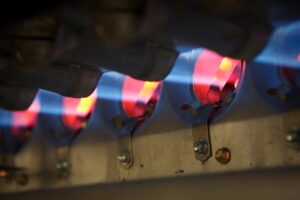
It likely goes without saying for residents here in Maumee or one of the surrounding communities that it gets pretty dang cold in the winter! As such, you use your heater on a regular basis, counting on it to keep you comfortable as well as safe.
Did you have it professionally tuned-up before the winter season started? The good news is, that even if you answered “no” to this question the only time it’s too late is if your heater completely broke down and is beyond repair. Skipping maintenance even one year can leave you with surprise repair needs that will cost a lot and could even be dangerous.
One repair need to be especially aware of, if you have a gas-powered heater, is replacing a damaged heat exchanger (or replacing the whole system if the problem is severe enough). Look, gas-powered heaters on not inherently dangerous. But yours can absolutely become so if you neglect this vital component. Keep reading to learn more!
The Job of the Heat Exchanger
This is the device that makes it possible for your furnace to actually provide heat to your home. The air traveling through your ventilation system via the blower fan travels over the heat exchangers first to pick up heat. The heat exchangers are filled with hot combustion gas once the burners come on, and their metal walls get very hot.
Heat exchangers are essentially protecting your household from combustion gasses, as their metal walls are the only thing standing between those combustion gasses and the air coming into your home.
When everything is functioning as it should, once the heating cycle ends, the combustion byproducts inside the heat exchanger get vented out of the furnace through a flue that releases the gas harmlessly outside.
When the Heat Exchanger Gets Damaged
Your furnace heat exchangers expand and contract as they heat up and then cool down. This type of stress will cause strain on the heat exchangers until they eventually start to crack or corrode. Corrosion happens due to the reaction between the combustion gas and the metal. This is typically only a problem if the furnace system is not properly vented, but is not outside of the realm of possibility otherwise, especially with an aging system (10-15 years old).
These cracks we’re talking about are barely noticeable to the average human eye, because they are microscopic. However, when the heat exchangers are hot, they expand enough that these cracks will open and can let out combustion gas that could then enter your living space. The most harmful of these gasses is carbon monoxide (CO). CO makes hundreds of Americans ill every year, and even leads to fatalities.
Signs of a Cracked Heat Exchanger
So now you know why a cracked heat exchanger is bad, but do you know how to tell if you have this problem? After all, we just said these cracks are microscopic. Here are some signs to watch out/listen for.
- Your furnace is old and/or ill-maintained. Heat exchanger damage is a lot more common in 10-15-year-old systems, especially if you don’t keep up on your annual tune-ups.
- You hear a lot of clicking as your furnace cycles off. This is indicative of a cooling, damaged, heat exchanger contracting back into place.
Contact AW Heating & Cooling today for quality heating services in Maumee, OH.
